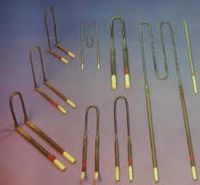Heating Elements
Heating elements convert electricity into heat through the process of Joule heating. Electric current through the element encounters resistance, resulting in heating of the element.
Most heating elements use Nichrome 80/20 (80% nickel, 20% chromium) wire, ribbon, or strip. Nichrome 80/20 is an ideal material, because it has relatively high resistance and forms an adherent layer of chromium oxide when it is heated for the first time. Material beneath this layer will not oxidize, preventing the wire from breaking or burning out.
Common Types
Coil / Spring / Spiral Type Metallic Heating Elements
Coil / Spring / Spiral Type Metallic Heating Elements finds applications in various kinds of Furnaces and ovens. The can be installed in grooves or can be installed on tube depending upon the requirement of furnaces. These can be also be embedded in vacuum formed ceramic fibre boards. These are normally used in all types of heating furnaces like Heat Treatment Industry, Petrochemical, Mining Industry, Engineering Industry.
Strip Heating Elements
These elements can be suspended over ceramic real or anchors. These are easier to install and has longer life compared to coiled heaters.
Oil and Water Heating Elements
Commonly made of Copper sheathed heating element, brazed to a brass flange provide with cap for protection of terminals, Nickel-plated. These are mostly used in Light duty (intermittent) boilers, washing machines, geysers , sterilizers and other commercial purpose .
Video
